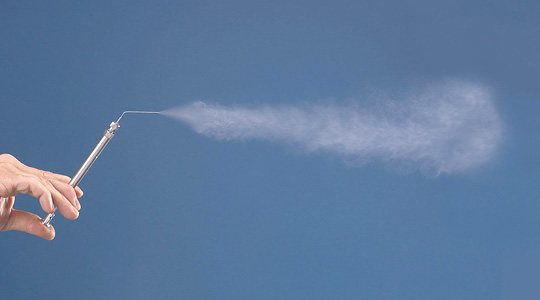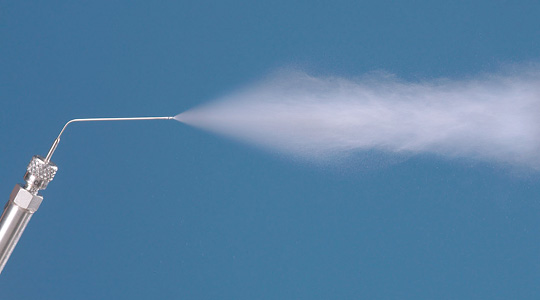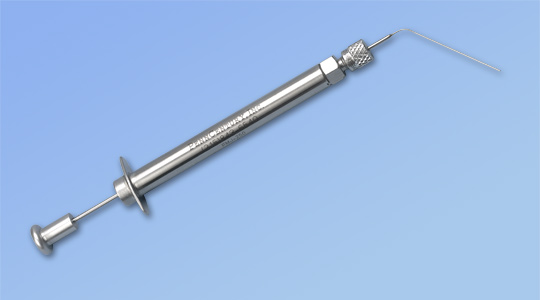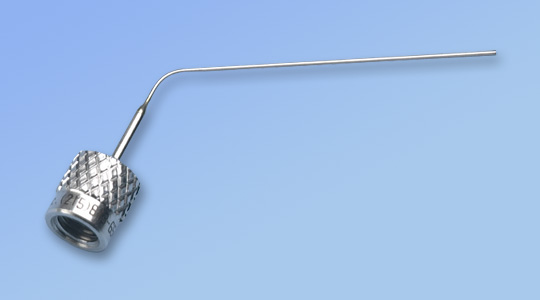
Model Number:
IA-1C-M
The MicroSprayer® Aerosolizer – Model IA-1C-M is designed for fast, targeted, air-free intratracheal aerosol administration to mouse. The device can be used to administer a precisely quantifiable, highly-concentrated, air-free plume of liquid aerosol directly into the lungs or other locations. It may also be used for intranasal or in vitro applications. It can aerosolize a wide range of liquids or particle solutions/suspensions, including pharmaceutical and biologic formulations, contrast/imaging agents and toxicological materials. (It does not administer dry powders.)
For intrapulmonary applications, the tip of the device is gently inserted down the trachea of the anesthetized animal – near to, but not touching the carina (first bifurcation). The portion that is inserted into the trachea measures 1.25″. It requires use of Penn-Century’s patented FMJ-250 High Pressure Syringe.
- Quick, precise aerosol dosing directly to the lungs – with no waste
- Purely mechanical, air-free technology
- Uses no heat, propellant, ultrasound or compressed air. No air burden to subject.
- Unique patented design is light, hand-held, easy to use
- Rounded tip permits safe, gentle intratracheal insertion
- Fully sterilizable, autoclavable and reusable
- Delivers a far higher volume and concentration than is possible with nebulizer/inhalation systems
- Produces a far broader, more uniform distribution than liquid bolus/droplet instillation methods
- Materials: Based on flexible, 23-gauge stainless steel tubing and other chemically resistant components
- 120-degree bend: All standard devices made with a 120-degree bend to make it easier to see around one’s hand when trying to view the epiglottis. (Straight custom devices can be ordered.)
- Length of intratracheal portion: 1.25″
- Hub: 1/4-28 tpi
- Tip is rounded to avoid harm to delicate tissues during insertion.
- Operates only with: Penn-Century’s patented FMJ-250 High Pressure Syringe (REQUIRED)
- Dose range: When used with FMJ-250 High Pressure Syringe, can administer dose volumes up to 250 microliters, or multiple smaller doses of 25 to 50 microliters or combinations of those dose volumes, using dosing spacers provided.
- Outer diameter: .025″ (0.64 mm), except at the very tip which is .028″ (0.71mm)
- Inner diameter: .017″ (0.43 mm) (NOTE: Liquid passes through patented aerosol components at the very tip. The diameter of these passageways in the Model IA-1C is approximately 60 microns in diameter. )
- Re-usable/Sterilizable: Can be cleaned and sterilized with very hot (filtered or distilled) water, organic solvents, by autoclave or ultrasound.
When analyzed with water, using Penn-Century’s FMJ-250 High Pressure Syringe, the MicroSprayer® Aerosolizer – Model IA-1C produced a particle size distribution with a Mass Median Diameter (MMD) of 16-22 µm (microns) – when analyzed by laser defraction. NOTE: Results may vary, depending upon method of particle size analysis used, the material delivered and the length of the MicroSprayer® Aerosolizer.
The following devices are helpful when working with the MicroSprayer® Aerosolizer – Model IA-1C-M in Mouse. The Microsprayer® Aerosolizer Pulmonary Aerosol Kit for Mouse (PAK-MSA), is also available and includes everything you need for a liquid intratracheal aerosol study in mice, at a discounted price.
- FMJ-250 High-Pressure Syringe
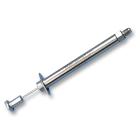
Model Number: FMJ-250 Description Specifications Accessories User Info The FMJ-250 High Pressure Syringe is unique, patented instrument syringe that permits air-free aerosol administration of precise doses of either 25µl or 50µl (or combinations of those volumes) up to a maximum of 250µl. It is the only syringe of its kind and is required for use… Continue reading
$1,450.00
REQUIRED FOR USE- FMJ-250 High-Pressure Syringe
- Small Animal Laryngoscope – Model LS-2-M for Mouse
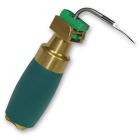
Model Number: LS-2-M Description Specifications Diagram User Info Penn-Century’s Small Animal Laryngoscope Model LS-2-M is specifically designed for use in mouse. It provides bright, clear illumination for better visualization of the trachea and epiglottis. It makes intratracheal intubation and insertion of Penn-Century’s MicroSprayer® Aerosolizers and Dry Powder Insufflators™ easier, quicker and safer. Each laryngoscope comes… Continue reading
$1,350.00
- Small Animal Laryngoscope – Model LS-2-M for Mouse
- Mouse Intubation Platform – Model MIP
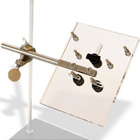
Model Number: MIP Description Specifications Diagram User Info Intratracheal intubation of anesthetized mice can pose challenges due to the animal’s small size, unique anatomy and the difficulty in visualizing the epiglottis. Researchers performing intratracheal aerosol administration in mice with Penn-Century’s unique MicroSprayer® Aerosolizer and Dry Powder Insufflator™ face similar challenges. The Penn-Century Mouse Intubation Platform… Continue reading
$690.00
- Mouse Intubation Platform – Model MIP
- Reverse Cleaning Adapter – RCA-1C
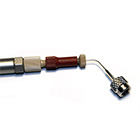
Model Number: RCA-1C Description User Info A new tool to clear blockages in the tip of your MicroSprayer® Aerosolizer Model IA-1C. The Penn-Century MicroSprayer® Aerosolizer – Model IA-1C is a unique, air-free atomizer. It generates an aerosol when liquids, solutions or particle suspensions are pushed at high manual pressure through tiny patented aerosolizing components in… Continue reading
$75.00
- Reverse Cleaning Adapter – RCA-1C
Dimensions (approx.)
| A | B | C |
|---|---|---|
| 1.25″ | 120° | 1″ |
Key:
Length “A”: Functional length, from bend to tip
Angle “B”: Angle of bend
Length “C”: Length from hub to bend
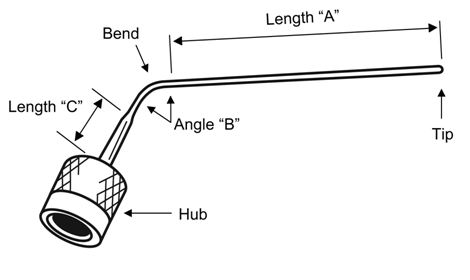
For intratracheal applications in small animals, the MicroSprayer® Aerosolizer Model IA-1C is usually inserted directly into the trachea. The intratracheal portion of the Model IA-1C is designed to reach from the front incisors to the carina in a standard laboratory mouse. NOTE: Users may also pre-intubate the animal and insert the device via an endotracheal tube. Doing so requires that the user calculate the measurements carefully:
- If the Model IA-1C is inserted into an endotracheal tube, the distal tip must emerge slightly (approximately 1 cm) from the end of the endotracheal tube when it is in position
- To avoid injury, neither the distal tip of endotracheal tube nor the distal tip of MicroSprayer® Aerosolizer should make contact with the carina when the plunger of the syringe is pushed
Intratracheal use of Penn-Century devices
For best results, position the tip
of the device near to – but not
touching the carina, or first
bifurcation.
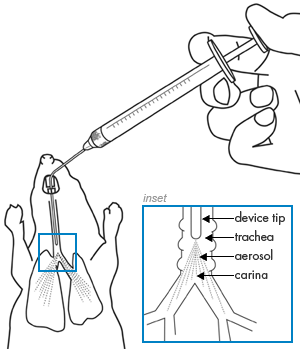
The process of intratracheal administration is essentially a form of intubation. For intrapulmonary applications, the tip of the device is gently inserted down the trachea of the anesthetized animal – near to, but not touching the carina (first bifurcation).
For planning help, see our Instructions for Use of the MicroSprayer® Aerosolizer – IA-1C.

